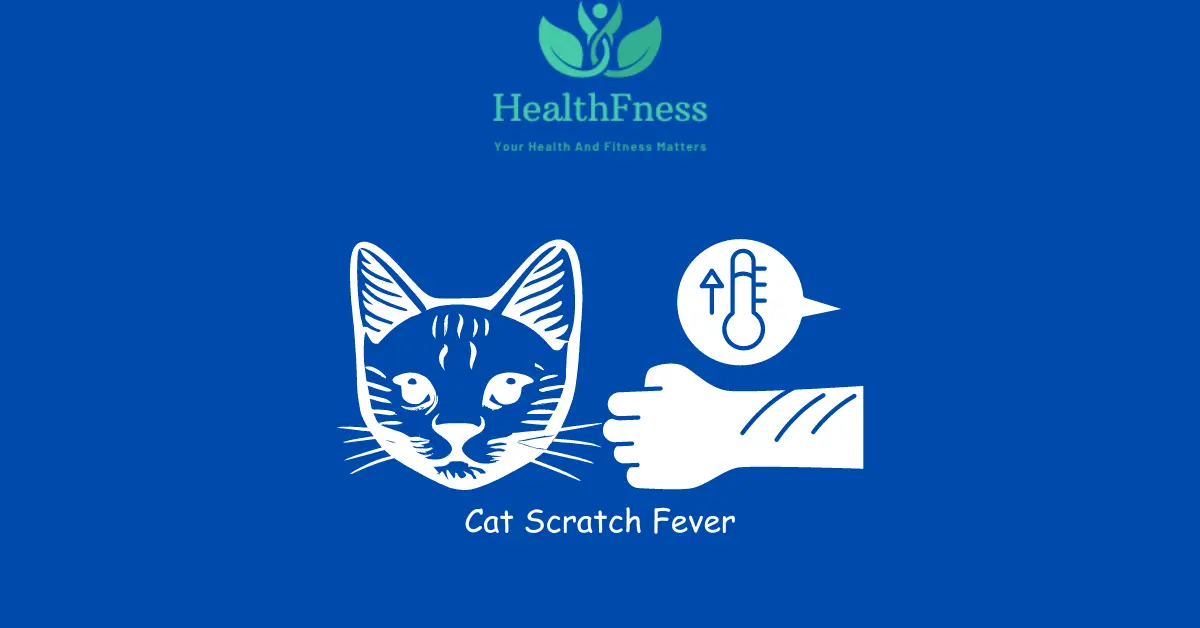A bacterial infection that people can contract from cats is cat scratch fever, often known as cat scratch disease (CSD). It usually happens when a person is bitten or scratched by an infected cat, and it is brought on by the bacterium Bartonella henselae. This article will provide you with a thorough overview of cat scratch fever by examining its signs, causes, and available treatments.
Understanding Cat Scratch Fever
What is Cat Scratch Fever?
The bacteria Bartonella henselae is the source of cat scratch fever, also known as cat scratch disease (CSD), an infectious illness. It mainly spreads to people when infected cats scratch or bite them. Despite the fact that the majority of cat scratch fever cases are benign and go away on their own, some people may have really bad symptoms. There is a case study of two brothers on cat scratch disease you can read for further information.
You May Also Like To Read: Cat Scratch Disease ↗
What is Cat Scratch Disease?
One study done by Am Fam Physician can answer this question.
Cat-scratch disease (CSD) is a common infection caused by Bartonella henselae, often presenting as tender lymphadenopathy. Diagnosis is typically based on clinical presentation and serological testing. Most cases resolve without antibiotics, but severe forms may require treatment.
How is Cat Scratch Fever Transmitted?
Direct contact with the saliva of an infected cat, as well as a scratch or bite from one, are the only ways to contract cat scratch fever. The bacterium is more likely to be carried by kittens, and fleas can also spread it. Cat scratch disease develops when an infected flea scratches a cat and the bacteria get into their circulation. It’s crucial to remember that cats are the main hosts of Bartonella henselae, and despite the fact that they frequently exhibit no symptoms of sickness, they can still spread the infection to people through bites or scratches.
How Can You Get Cat Scratch Fever?
Cat scratches or cat bites are the main method of transmission for cat scratch fever, also known as cat scratch disease (CSD). A person may become infected when they are scratched or bitten by a cat that is carrying the Bartonella henselae bacteria. Not all cats contain the bacterium, but those that do can spread it to humans, thus this needs to be noted.
What is Cat Scratch Fever Bumps?
Small raised patches or lesions known as “cat scratch fever bumps” may develop at the site of a cat bite or scratch from an infected cat. One of the initial signs of cat scratch fever, commonly known as cat scratch sickness or CSD, is frequently these lumps.
These pimples can appear when the bacterium Bartonella henselae enters the body with a bite or scratch and triggers an immune response. Small red papules or blisters may resemble the bumps, and they may also be accompanied by localized discomfort and swelling.
Can Adults Get Cat Scratch Fever?
Yes, cat scratch fever may affect adults. A bacterium known as Bartonella henselae is the root cause of cat scratch fever, sometimes referred to as cat scratch disease (CSD). This bacterium is frequently found in cats, particularly in their saliva, and it can be spread to people by a cat’s scratch or bite.
The germs can enter a person’s body through a break in the skin when a cat bites or scratches them. This may result in an infection that has signs including a tiny bump or blister at the bite or scratch’s location, swollen lymph nodes close by lethargy, fever, headaches, and body aches. People may occasionally also develop a rash or lose their appetite.
You May Also Like To Read: Side Effects of Cat Scratch: Understanding the Risks and Precautions
Who is at Risk?
Cat scratch fever could infect everyone who owns or interacts with cats. However, some people are more prone to experiencing severe symptoms, such as young children, the elderly, and those with compromised immune systems.
Cat Scratch Fever Symptoms
Early Signs
The following are possible early signs of infected cat scratch:
- A little lump or blister where the bite or scratch was located
- Near the site of a bite or scratch, swollen lymph nodes
- Fatigue
- Fever
Advanced Symptoms
If the infection worsens, more severe symptoms could develop, including:
- Persistent fever
- Headache
- Body pains
- Unwell throat
- Reduced appetite
- Rash
- Spleen or liver growth
Diagnosing Cat Scratch Fever
Physical Examination
Your healthcare practitioner will check the lymph nodes close to the affected area during a physical examination and search for any indications of infection or inflammation. They could also ask whether there have been any recent cat encounters like bites or scratches.
Laboratory Tests
Your doctor might request laboratory testing, such as a blood test or a lymph node biopsy, to confirm the diagnosis. These examinations can look for antibodies to the Bartonella henselae bacteria or identify its existence.
Cat Scratch Fever Treatment
Taking Care of Oneself
Self-care techniques can be useful for treating cat scratch fever in mild cases. These may consist of:
- Thoroughly wash the wound with soap and water
- Applying an ointment of antibiotic over-the-counter
- Taking painkillers to get relief from discomfort
Medications
To treat the infection and avoid problems in more serious situations, your doctor may prescribe antibiotics like azithromycin or doxycycline. The length of the antibiotic treatment will depend on how severe the symptoms are and how healthy the patient is generally. These factors will decide the time span of treatment.
Severe Cases
Rarely, when difficulties develop, additional therapies can be required. These can involve doing surgery or giving intravenous antibiotics.
How To Prevent Cat Scratch Disease
Handling Cats Safely
When handling cats, take the following steps to lower the risk of cat scratch fever:
- Avoid rough play that could cause bites or scratches.
- After handling cats, make sure to fully wash your hands, especially before eating.
- Regularly trim your cat’s nails to reduce the chance of serious scratches.
Proper Wound Care
Follow these instructions for proper wound care if a cat has bitten or scratched you:
- Use soap and water to clean the afflicted area.
- To avoid infection, use an antiseptic cream.
- Put a fresh bandage over the wound.
Regular Veterinary Check-ups
Make sure your cat gets routine checkups and preventative care from the vet, including flea treatment. This lessens the possibility of cats picking up the Bartonella henselae bacterium.
FAQS
Can you get cat scratch fever from a cat lick?
No, licking does not spread cat scratch fever; rather, it is primarily spread by cat scratches or bites.
How long does cat scratch fever last?
Different people experience cat scratch fever for different lengths of time. The majority of the time, symptoms go away in a few weeks. The lymph nodes may not enlarge to their usual size for several months, though.
Can you prevent cat scratch fever?
Even if the risk cannot be completely eliminated, you can lower it by taking the right precautions, such as refraining from physical play with cats and maintaining good cleanliness.
Is cat scratch fever contagious?
Direct transmission of cat scratch fever is not possible. Contact with infected cats is the only way to spread it.
Are all cats carriers of Bartonella henselae?
The bacterium Bartonella henselae is not present in all cats. However, it's believed that a sizable portion of cats could have the disease at some time in their life.
How serious is cat scratch fever?
Cat scratch fever isn't typically serious but can have complications in some cases.
How do you treat cat scratch fever in humans?
Treatment usually involves antibiotics if symptoms are severe or complications arise.
Is cat scratch fever self-healing?
Is cat scratch fever the same as rabies?
No, cat scratch fever is caused by bacteria, while rabies is caused by a virus.
How do I know if my cat has scratch fever?
Watch for symptoms like lethargy, fever, loss of appetite, swollen lymph nodes, or joint pain, and consult a veterinarian if you're concerned.
Conclusion
Cats can transmit the bacterial infection known as cat scratch fever, which is brought on by Bartonella henselae. Even though the majority of instances are minor and go away on their own, it’s crucial to be aware of the symptoms, particularly in people with compromised immune systems. You can reduce the risk and effects of cat scratch fever by taking the right precautions, maintaining excellent cleanliness, and getting medical help when required.

Dr. Mark Jenkins, MD - General Physician (California, USA)
Dr. Mark Jenkins is a board-certified general physician based in the United States, specializing in preventive medicine, nutrition, and lifestyle health. With years of clinical experience in primary care, he is dedicated to helping patients and readers alike make informed, science-based decisions about their well-being.
As a trusted medical reviewer and contributor to Healthfness.com, Dr. Jenkins ensures that all health content meets the highest standards of accuracy, safety, and evidence-based medicine. His expertise bridges modern medical science with practical, everyday wellness strategies, making complex topics approachable for all audiences.
Outside the clinic, Dr. Jenkins is passionate about living the healthy lifestyle he teaches. He enjoys hiking with his dog, experimenting with vegetarian cooking, and exploring the latest health research. He believes that small, consistent lifestyle changes lead to lasting health improvements, and he aims to inspire readers to take proactive steps toward a healthier, happier life.
Explore more of Dr. Jenkins’ evidence-based insights at Healthfness.com



